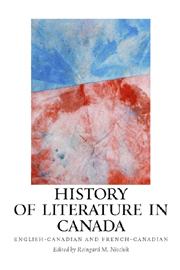Book contents
- Frontmatter
- Contents
- Acknowledgments
- Introduction: Writing a History of Literature in Canada
- I Beginnings
- II The Literature of New France, 1604–1760
- III The Literature of British Canada, 1763–1867
- IV From the Dominion to the Territorial Completion of the Nation, 1867–1918
- V The Modern Period, 1918–1967
- VI Literature from 1967 to the Present
- 21 Sociopolitical and Cultural Developments from 1967 to the Present
- 22 English-Canadian Literary Theory and Literary Criticism
- 23 The English-Canadian Novel from Modernism to Postmodernism
- 24 The English-Canadian Short Story since 1967: Between (Post)Modernism and (Neo)Realism
- 25 English-Canadian Poetry from 1967 to the Present
- 26 Contemporary English-Canadian Drama and Theater
- 27 Canons of Diversity in Contemporary English-Canadian Literature
- 28 Literature of the First Nations, Inuit, and Métis
- 29 The Quebec Novel
- 30 The French-Canadian Short Prose Narrative
- 31 French-Canadian Poetry from 1967 to the Present
- 32 Orality and the French-Canadian Chanson
- 33 Drama and Theater from the Révolution tranquille to the Present
- 34 Transculturalism and écritures migrantes
- 35 The Institutionalization of Literature in Quebec
- Further Reading
- Notes on the Contributors
- Index
30 - The French-Canadian Short Prose Narrative
from VI - Literature from 1967 to the Present
Published online by Cambridge University Press: 12 September 2012
- Frontmatter
- Contents
- Acknowledgments
- Introduction: Writing a History of Literature in Canada
- I Beginnings
- II The Literature of New France, 1604–1760
- III The Literature of British Canada, 1763–1867
- IV From the Dominion to the Territorial Completion of the Nation, 1867–1918
- V The Modern Period, 1918–1967
- VI Literature from 1967 to the Present
- 21 Sociopolitical and Cultural Developments from 1967 to the Present
- 22 English-Canadian Literary Theory and Literary Criticism
- 23 The English-Canadian Novel from Modernism to Postmodernism
- 24 The English-Canadian Short Story since 1967: Between (Post)Modernism and (Neo)Realism
- 25 English-Canadian Poetry from 1967 to the Present
- 26 Contemporary English-Canadian Drama and Theater
- 27 Canons of Diversity in Contemporary English-Canadian Literature
- 28 Literature of the First Nations, Inuit, and Métis
- 29 The Quebec Novel
- 30 The French-Canadian Short Prose Narrative
- 31 French-Canadian Poetry from 1967 to the Present
- 32 Orality and the French-Canadian Chanson
- 33 Drama and Theater from the Révolution tranquille to the Present
- 34 Transculturalism and écritures migrantes
- 35 The Institutionalization of Literature in Quebec
- Further Reading
- Notes on the Contributors
- Index
Summary
FOR A LONG TIME Quebec short fiction did not rank highly in the hierarchy of genres. In the 1980s and 1990s, however, it experienced a boom in popularity, with the number of publications steadily rising: In the early 1970s only about ten short-story volumes had been published per annum, whereas the 1990s saw an average of thirty to thirty-five volumes published per year, not to mention publications in numerous journals and weekly as well as daily newspapers. From the mid-1970s onwards a great thematic and formal diversity could be found in French-Canadian short stories. This diversity, characterized by a seemingly unlimited eagerness to experiment, heralded the golden age of the short story in Quebec, as literary critics often call the last two decades of the twentieth century.
The short stories of the early 1970s did not differ greatly from those of the previous decades. There are some exceptions, such as Claude Robitaille's volumes Rachel-du-hasard (1971) and Le temps parle et rien ne se passe (1974), Louis-Philippe Hébert's Le cinéma de petite-rivière (1974), Textes extraits de vanille (1974), and Textes d'accompagnement (1975), and Albert-G. Paquette's Quand les québécoisiers en fleurs … (1973), which were all written in a progressive style, renouncing traditional narrative linearity. Most authors, however, remained committed to socio-critical and psychological realism, used folkloristic elements of the oral narrative, or dealt with previous times in autobiographical short stories. Often short-story volumes were produced by already established novelists or critics such as Gilles Archambault (Enfances lointaines, 1972), Jean Éthier-Blais (Le manteau de Rubén Dario, 1974), Adrienne Choquette (Le temps des villages, 1975), or Yves Thériault (Oeuvre de chair, 1975).
- Type
- Chapter
- Information
- History of Literature in CanadaEnglish-Canadian and French-Canadian, pp. 450 - 455Publisher: Boydell & BrewerPrint publication year: 2008



